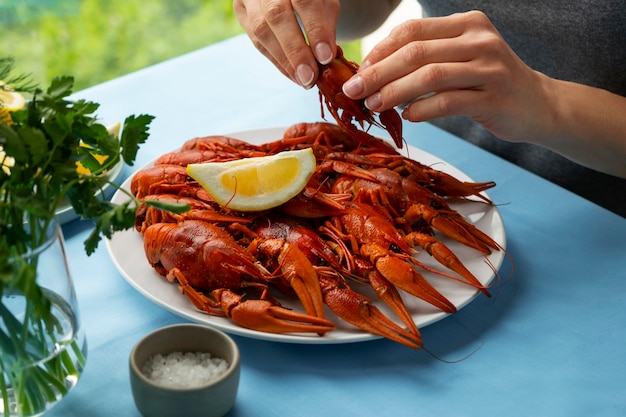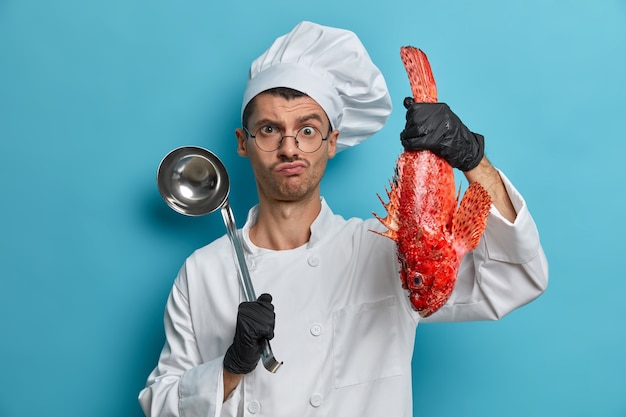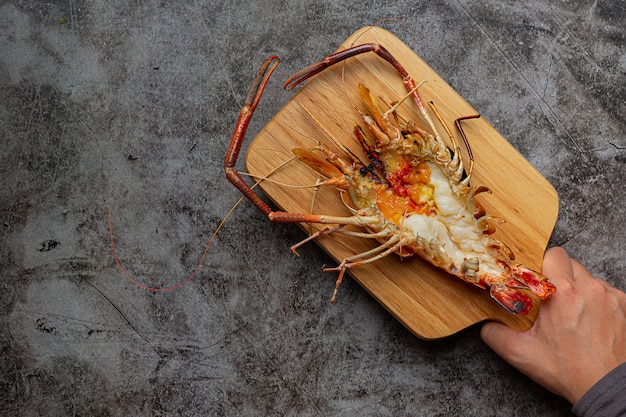Ah, lobster. The mere mention of the word conjures images of elegant dinners, seaside feasts, and a taste that's simply unforgettable. But for those of us who aren't seasoned lobster chefs, the thought of tackling this crustacean can feel a bit daunting. Fear not, my friends! I'm here to guide you through every step of the lobster cooking journey, from selecting the perfect specimen to cracking open its shell and savoring each succulent bite.
Over the years, I've cooked my fair share of lobster. It's a process that's become more than just a recipe; it's a ritual, a connection to the sea, and a celebration of culinary creativity. Join me as I share my insights, my favorite techniques, and maybe even a few funny stories from my lobster-cooking adventures. By the end of this guide, you'll be equipped to impress your friends and family with a lobster meal that's both delicious and unforgettable.
(Part 1) The Art of Selecting the perfect lobster

The journey begins at the fishmonger's, a bustling haven of fresh seafood. Selecting a lobster is a bit like choosing a fine wine - it requires a discerning eye and a bit of knowledge. You wouldn't just grab the first bottle you see, would you? No, you'd examine the label, consider the vintage, and think about the occasion. Lobster is no different. Here's how to find your perfect catch:
1. A Lobster's Appearance Speaks Volumes
A truly good lobster should be full of life, with bright, clear eyes that seem to sparkle with energy. Its shell should be smooth and shiny, free of cracks or blemishes. Think of it as a lobster's "beauty pageant" - you want one that stands out from the crowd! Pick it up and give it a gentle feel. A heavy lobster is a healthy lobster, brimming with succulent meat.
2. Size Matters (But Not Always)
The size of your lobster depends entirely on how many mouths you're feeding. For a solo dinner, a 1-1.5lb lobster is a perfect size. For a family feast, you might need two or three, depending on everyone's appetite. For a crowd, well, you'll want to stock up on a few more! Remember, a bigger lobster usually comes with a heftier price tag. Choose wisely!
3. The Gender Debate: Hen or Rooster?
Now, this might sound a bit odd, but the sex of the lobster can actually affect its flavor. Female lobsters, also known as "hens," are often considered more tender and sweeter than their male counterparts. You can distinguish between the sexes by looking at the underside of their tails. A female lobster will have a small, triangular flap called an "apron", while a male will have two small, pointed appendages. Personally, I find this distinction a bit of a myth, and believe both sexes deliver their own unique flavor profiles. Ultimately, it's a matter of personal preference.
(Part 2) Prepping for the Big Boil: A Lobster's Spa Day

You've got your perfect lobster, now it's time to get it ready for its transformation into a culinary masterpiece. This might sound complicated, but trust me, it's a breeze. Think of it as giving your lobster a little spa treatment before its big performance.
1. A Moment of Calm: A Chill for the Lobster
First things first, give your lobster a little chill-out time. Pop it in the fridge for about 30 minutes before you start cooking. This will help calm the lobster down and make it easier to handle. You wouldn't want your star chef to be too stressed, would you?
2. Taming the Claws: A Little Bandaging
Now, you need to prevent those powerful claws from doing any damage. Grab a rubber band or a piece of string and tie it tightly around the base of the claws. This will stop them from snapping and potentially pinching anyone. It's a simple precaution, but a necessary one. Trust me, you'll thank me later when your fingers are still intact.
3. A Sparkling Clean: A Good Wash
Next, give your lobster a thorough wash under cold running water. This will remove any dirt, sand, or other debris that might be clinging to its shell. A clean lobster is a happy lobster, and a happy lobster means a delicious dinner!
4. The Stomach Sack: A Matter of Preference
If you're feeling particularly adventurous, you can remove the lobster's stomach sack. It's a small, black sac located on the underside of the lobster's belly. It's perfectly safe to eat, but some find it a bit unpleasant. I usually remove it just for a cleaner, more elegant presentation. It's your call, but I'm all about a beautiful dish.
(Part 3) The Classic Boil: A Simple and Delicious Method

Now, let's get to the good stuff – the cooking! There are several ways to cook a lobster, but boiling remains my personal favorite. It's simple, reliable, and produces the most delicious results, in my opinion. Here's how to make it happen:
1. The Boiling Pot: Big and Bubbling
Start by filling a large pot with enough water to completely submerge the lobster. Don't be shy with the water; you want the lobster to be swimming in it, not cramped.
2. The Seasoning: A Symphony of Flavors
Now, let's add some flavor! This is where you can get creative and add your own personal touch. I prefer a simple mix of salt, peppercorns, and bay leaves. You can also throw in some herbs like thyme or rosemary, or even a squeeze of lemon juice for a zesty kick. But remember, you don't want to overpower the delicate taste of the lobster.
3. The Boil: A Dramatic Entrance
Bring the water to a rolling boil. It should be bubbling vigorously, not just simmering. Once it's boiling, carefully lower the lobster into the pot, making sure it's completely submerged. It might seem a bit dramatic, but doing this quickly and efficiently is essential. You don't want to stress out your lobster; you want it to relax and enjoy its final moments.
4. The Timer: A Matter of Time
Now comes the crucial part – the cooking time. The general rule is to cook a 1lb lobster for about 12-15 minutes. For larger lobsters, add a few more minutes. You can check if it's cooked through by examining the flesh around the tail. It should be firm and opaque, not translucent. You can also twist the tail; if it comes off easily, it's done.
5. The Chill: A Cooling Down Period
Once your lobster is cooked, remove it from the pot and plunge it into a bowl of ice water. This will stop the cooking process and prevent it from overcooking. It also makes it easier to handle, as the shell will cool down and become less fragile.
(Part 4) The Steaming Method: Gentle and Delicate
If you prefer a more delicate flavor and a slightly softer texture, steaming is a great alternative to boiling. It's also a fantastic option if you're cooking multiple lobsters at once, as you can fit them all into a steamer basket without them bumping into each other.
1. The Steamer: A Symphony of Steam
Fill the bottom of a steamer pot with about an inch of water and add your favorite seasonings. I'm partial to a mix of salt, peppercorns, bay leaves, and a sprig of rosemary.
2. The Basket: A Cozy Home for the Lobster
Place the lobster in a steamer basket and set it over the simmering water. Make sure the basket is not touching the water. The steam will cook the lobster evenly and gently.
3. The Timer: Steaming Away
The steaming time is similar to boiling, about 12-15 minutes for a 1lb lobster. You can tell if it's cooked through by checking the flesh around the tail. It should be firm and opaque, not translucent. You can also twist the tail – if it comes off easily, it’s cooked through.
4. The Chill: A Refreshing Dip
Once the lobster is cooked, remove it from the steamer and plunge it into a bowl of ice water. This will stop the cooking process and prevent the lobster from overcooking.
(Part 5) The Grilling Method: Smoky and Bold
For a more intense flavor and a hint of char, grilling is a fantastic choice. It's a wonderful way to add a smoky depth to the lobster's natural sweetness. Just be careful not to overcook it, as the flesh can dry out quickly on the grill.
1. The Prep: Getting Ready to Grill
Start by preheating your grill to medium-high heat. You can use a gas grill, charcoal grill, or even a grill pan on the stovetop. Then, split the lobster lengthwise and remove the digestive tract.
2. The Marinade: Flavors that Sing
This is where you can really let your creativity shine. I love to marinate my lobster in a simple blend of olive oil, garlic, lemon juice, and herbs like thyme and rosemary. You can also add other spices, like paprika or chili flakes, for a touch of heat. Let the lobster marinate for at least 30 minutes, or up to an hour, for the flavors to really infuse.
3. The Grill: A Smoky Transformation
Place the lobster halves flesh-side down on the grill and close the lid. Cook for about 5-7 minutes, or until the flesh is opaque and cooked through. You might need to flip the lobster halves halfway through cooking to ensure even browning.
4. The Finish: A Touch of Butter
Once the lobster is cooked, remove it from the grill and brush it with melted butter. This will add a rich, buttery flavor and help to keep the flesh moist. Serve immediately.
(Part 6) Cracking the Shell: A culinary adventure
The moment of truth has arrived. It's time to crack open that shell and reveal the juicy, succulent flesh inside. This is where the real fun begins. It's a hands-on experience, a bit messy, but totally worth it.
1. The Tools: A culinary arsenal
You'll need a few tools to help you crack open the shell. A lobster cracker is essential for tackling the tough claws. You can also use a sturdy kitchen knife or a pair of heavy-duty scissors to cut through the shell.
2. The Claws: A Treasure Trove of Meat
Start by cracking the claws. Place the claw on a cutting board and use the lobster cracker to break the shell at the joint. You'll hear a satisfying crack as the shell gives way. You can then use the knife or scissors to cut through any remaining shell and extract the meat.
3. The Tail: Sweet and Tender
Next, tackle the tail. Twist the tail off the body, then use your fingers to peel back the shell. This part of the lobster is usually filled with the most tender and flavorful meat.
4. The Body: A culinary puzzle
Finally, crack open the body and remove the remaining meat. This part is often a bit more challenging, but don't give up! You can use the knife or scissors to cut through the shell and pry out the meat. You can also use a fork to help you pull out the meat from the shell.
(Part 7) Serving and Savoring: A Culinary Triumph
Now that your lobster is cracked open and ready to eat, it's time to plate it up and enjoy the fruits of your labor. It's a moment to savor, a culinary triumph you've earned.
1. The Presentation: A Feast for the Eyes
There are endless ways to present your cooked lobster. You can serve it simply on a plate with a side of melted butter, or get creative with a more elaborate presentation. You can arrange the lobster pieces on a bed of salad greens, drizzle it with a flavorful sauce, or add some decorative garnishes.
2. The Accompaniments: Complementary Delights
Lobster is delicious on its own, but it can be even more enjoyable with the right accompaniments. Some classics include melted butter, lemon wedges, garlic bread, and a side of steamed vegetables.
3. The Savouring: A Moment of Pure Bliss
Finally, it's time to sit back, relax, and enjoy your masterpiece. Take your time and savor every bite. Let the tender, sweet meat melt in your mouth and appreciate the effort you put into preparing this luxurious meal.
(Part 8) Lobster Leftovers: Culinary Magic
You might be left with some lobster leftovers. Don't throw them away! They're too precious to waste. You can use the leftover lobster meat in a variety of delicious dishes. Here are a few ideas:
1. Lobster Salad: A Refreshing Delight
Combine leftover lobster meat with mayonnaise, celery, and onion for a refreshing and delicious salad. You can serve it on bread, crackers, or in lettuce cups.
2. lobster bisque: A Creamy Indulgence
Use the lobster shells and leftover meat to make a rich and creamy bisque. It's a classic way to use up leftovers and turn them into a new dish.
3. lobster mac and cheese: A Luxurious Twist
Add some leftover lobster meat to your mac and cheese for a luxurious upgrade. It's a simple but effective way to add a touch of elegance to a comfort food classic.
4. Lobster Pizza: A Decadent Treat
Top your pizza with leftover lobster meat and your favorite toppings for a decadent and flavorful treat. You can use a white pizza base or a traditional red sauce, depending on your preference.
(Part 9) FAQ: The Lobster Cooking Q&A
Here are some frequently asked questions about lobster cooking:
1. How Do I Know If My Lobster Is Cooked Through?
The best way to tell if a lobster is cooked through is to check the flesh around the tail. It should be firm and opaque, not translucent. You can also twist the tail – if it comes off easily, it’s cooked through.
2. Can I Freeze Leftover Lobster?
Yes, you can freeze leftover lobster. To freeze it, place it in an airtight container or freezer bag. You can freeze it for up to 3 months. When you're ready to use it, thaw the lobster in the fridge overnight or in cold water for a few hours.
3. How Long Can I Keep a live lobster in the Fridge?
You can keep a live lobster in the fridge for up to 24 hours. Place it in a container with a damp towel or seaweed to keep it moist. Make sure to keep it in the coldest part of your fridge, ideally around 37-40°F.
4. Can I Cook a Lobster Without Killing It First?
No, it is not possible to cook a lobster without killing it first. Lobsters are sentient creatures, and they feel pain. Therefore, it is considered cruel to cook a lobster while it is still alive.
5. What Are Some Other Tips for cooking lobster?
Here are some other tips for cooking lobster:
- Don’t overcook the lobster. Overcooked lobster can become tough and rubbery.
- Use a good quality lobster cracker to avoid any accidents. A poor-quality lobster cracker can slip and cause injury.
- Don’t be afraid to experiment with different flavors. Lobster pairs well with a variety of ingredients, so have fun and get creative.
(Part 10) The Lobster Experience: More Than Just a Meal
Cooking lobster is more than just a culinary experience; it's a journey. It's a journey of anticipation, of careful selection, of respecting a living creature and transforming it into a delicious meal. It's a journey that brings friends and family together, creating shared memories and stories.
The next time you find yourself at the fishmonger's, take a moment to admire the lobster's beauty, the way it moves, its shiny shell. And then, dare to take on the challenge. Cook it with care, and with a heart full of respect for the creature you are about to savor. You will not be disappointed.
Everyone is watching

How to Cook Frozen Lobster Tails Perfectly: A Step-by-Step Guide
RecipesLobster. Just the word conjures up images of lavish meals, special occasions, and a taste of luxury. But let's...

Pigs in a Blanket Cooking Time: How Long to Bake for Perfect Results
RecipesAh, pigs in a blanket. Just the name conjures up images of those delightful little parcels of crispy pastry en...

Pork Fillet Cooking Time: How Long to Cook It Perfectly
RecipesPork fillet, or tenderloin as it's sometimes called, is a real favourite in our house. It's so versatile, and...

The Ultimate Guide to Tender, Juicy Pulled Pork
RecipesRight, let's talk pulled pork. It's one of those dishes that just screams "comfort food," doesn't it? I mean...

The Ultimate Guide to Cooking Delicious Frankfurters
RecipesLet's face it, we all love a good frankfurter. It's a classic, simple, and always satisfying. But let's be rea...
